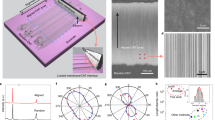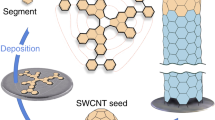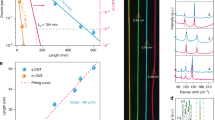Cunning refinements help to customize the architecture of nanotube structures.
Abstract
Nanoscale structures need to be arranged into well-defined configurations in order to build integrated systems. Here we use a chemical-vapour deposition method with gas-phase catalyst delivery to direct the assembly of carbon nanotubes in a variety of predetermined orientations onto silicon/silica substrates, building them into one-, two- and three-dimensional arrangements. The preference of nanotubes to grow selectively on and normal to silica surfaces forces them to inherit the lithographically machined template topography of their substrates, allowing the sites of nucleation and the direction of growth to be controlled.
This is a preview of subscription content, access via your institution
Access options
Subscribe to this journal
Receive 51 print issues and online access
$199.00 per year
only $3.90 per issue
Buy this article
- Purchase on Springer Link
- Instant access to full article PDF
Prices may be subject to local taxes which are calculated during checkout


Similar content being viewed by others
References
Dresselhaus, M. S., Dresselhaus, G. & Avouris, P. Carbon Nanotubes: Synthesis, Structure, Properties, and Applications (Springer, Heidelberg, 2001).
Li, W. Z. et al. Science 274, 1701–1703 (1996).
Sen, R., Govindaraj, A. & Rao, C. N. R. Chem. Phys. Lett. 267, 276–280 (1997).
Terrones, M. et al. Nature 388, 52–55 (1997).
Ren, Z. F. et al. Science 282, 1105–1107 (1998).
Fan, S. S. et al. Science 283, 512–514 (1999).
Kind, H. et al. Adv. Mater. 11, 1285–1289 (1999).
Schlittler, R. R. et al. Science 292, 1136–1139 (2001).
Zhang, Z. J., Wei, B. Q., Ramanath, G. & Ajayan, P. M. Appl. Phys. Lett. 77, 3764–3766 (2000).
Author information
Authors and Affiliations
Corresponding author
Rights and permissions
About this article
Cite this article
Wei, B., Vajtai, R., Jung, Y. et al. Organized assembly of carbon nanotubes. Nature 416, 495–496 (2002). https://doi.org/10.1038/416495a
Issue Date:
DOI: https://doi.org/10.1038/416495a
This article is cited by
-
Properties, assembly and characterization of carbon nanotubes: their application in water purification, environmental pollution control and biomedicines—a comprehensive review
Carbon Letters (2023)
-
Analysis on the synthesis of vertically aligned carbon nanotubes: growth mechanism and techniques
Journal of Materials Science: Materials in Electronics (2020)
-
Carbon nanotubes: synthesis, properties and engineering applications
Carbon Letters (2019)
-
Carbon-based materials for photodynamic therapy: A mini-review
Frontiers of Chemical Science and Engineering (2019)
-
Synthesis and mechanism perspectives of a carbon nanotube aerogel via a floating catalyst chemical vapour deposition method
Bulletin of Materials Science (2019)
Comments
By submitting a comment you agree to abide by our Terms and Community Guidelines. If you find something abusive or that does not comply with our terms or guidelines please flag it as inappropriate.



